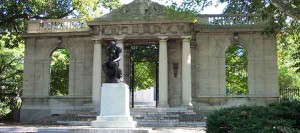The French sculptor, Auguste Rodin, spent the last 24 years of his life living in La Villa de Brillants, his rather grand estate in Meudon, outside Paris. Rodin collected antiquities, and one of his largest possessions was a freestanding section of façade of a seventeenth-century chateau that he had disassembled and moved from nearby Issy-les-Moulineux to his garden. In the 1920s, when Paul Cret was designing a museum in downtown Philadelphia to house Jules E. Mastbaum’s collection of Rodin sculptures, he incorporated a replica of the chateau façade into his design. (Mastbaum, the developer of a chain of movie houses, knew Rodin and had visited Meudon.) The freestanding section of façade forms an entryway into the Rodin Museum grounds, and after crossing the garden, designed by Jacques Gréber, one arrives at the museum itself and a portico dominated by the splendid Gates of Hell. When I visited the recently renovated museum, it struck me that Cret and Mastbaum’s masterly strategy of using a replica to evoke the spirit of Rodin might have informed the design of the new Barnes Foundation, which stands next door. The memory of the old Barnes in suburban Merion, a building that also happened to be designed by Cret, might have been allowed to affect the design of the new Barnes, not only on the interior (as the law required) but also on the exterior. Instead, we have a fussily clad masonry box surmounted by an ungainly glass construction. But more on the New Barnes later.
On Culture and Architecture

